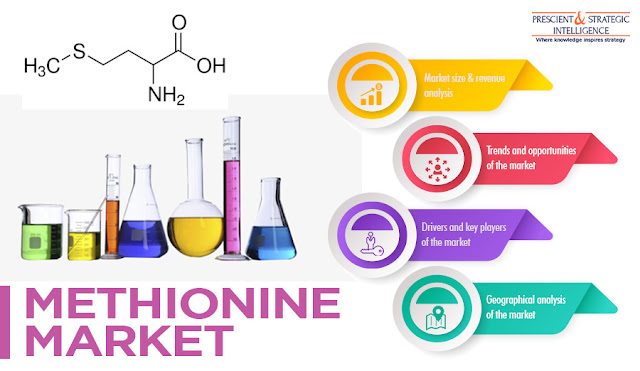Methionine, one of the nine essential amino acids, serves as a precursor to every sulfur-containing amino acid and their derivates. It is constantly regenerated from homocysteine through one-carbon metabolism. This amino acid is extensively found in chicken breast, eggs, salmon, mahi-mahi or dolphinfish, and halibut, spinaches, asparagus, mushrooms, zucchini, and dairy products. Additionally, methionine also acts as an antioxidant by providing sulfur atoms in cysteine synthesis. Inadequate intake of methionine can, therefore, have an adverse impact on the synthesis of cysteine, and hence glutathione (GSH), one of the primary endogenous antioxidants.
Owing to the high-volume methionine content in eggs and meat, the poultry industry is creating a high demand for animal feed, as this substance helps in the development and growth of the digestive tract of animals that are vital for enhancing muscle mass and increasing egg production of poultry animals. Thus, the surging consumption of animal feed in the poultry sector will accelerate the methionine market at a CAGR of 10.2% during forecast period. The market revenue stood at $5,114.3 million in 2017 and it is expected to reach $9,121.9 million by 2023.
In recent years, the usage of methionine has significantly increased in the pharmaceutical industry, due to its therapeutic advantages. This substance is widely used to treat liver cirrhosis, copper poisoning, toxic hepatitis, and pneumonia. According to the World Health Organization (WHO), chronic diseases are responsible for the deaths of around 35 million people each year. Methionine is used as a buffering agent in antacids and analgesics in treating these diseases. With the rising prevalence of liver cirrhosis, the requirement for this amino acid will escalate in the coming years.
Nowadays, the poultry industry and pharmaceutical sector have shifted to bio-methionine, due to the surging environmental concerns being raised across the world. Methionine is usually derived from petrochemical sources, which are hazardous and hard to handle. Due to this reason, biochemical routes are being explored to obtain methionine. For example, Arkema Group and CJ Cheiljedang Bio entered into a joint venture to initiate methionine manufacture from vital raw materials using innovative processes, owing to their higher sustainability than synthetic materials and eco-friendly nature.
According to P&S Intelligence, Asia-Pacific dominated the methionine market and adopted this essential amino acid at the highest rate in the recent past. The region is expected to adopt methionine at the fastest pace in the coming years as well. This can be ascribed to the burgeoning demand for animal feed in the region. Moreover, the presence of leading methionine manufacturers in the region will also fuel the production of this acid in the coming years. In the coming years, China will consume the highest quantity of methionine in APAC region.
Therefore, the surging need for animal feed and increasing consumption of pharmaceutical products will boost the need for methionine in the forthcoming years.









No comments:
Post a Comment